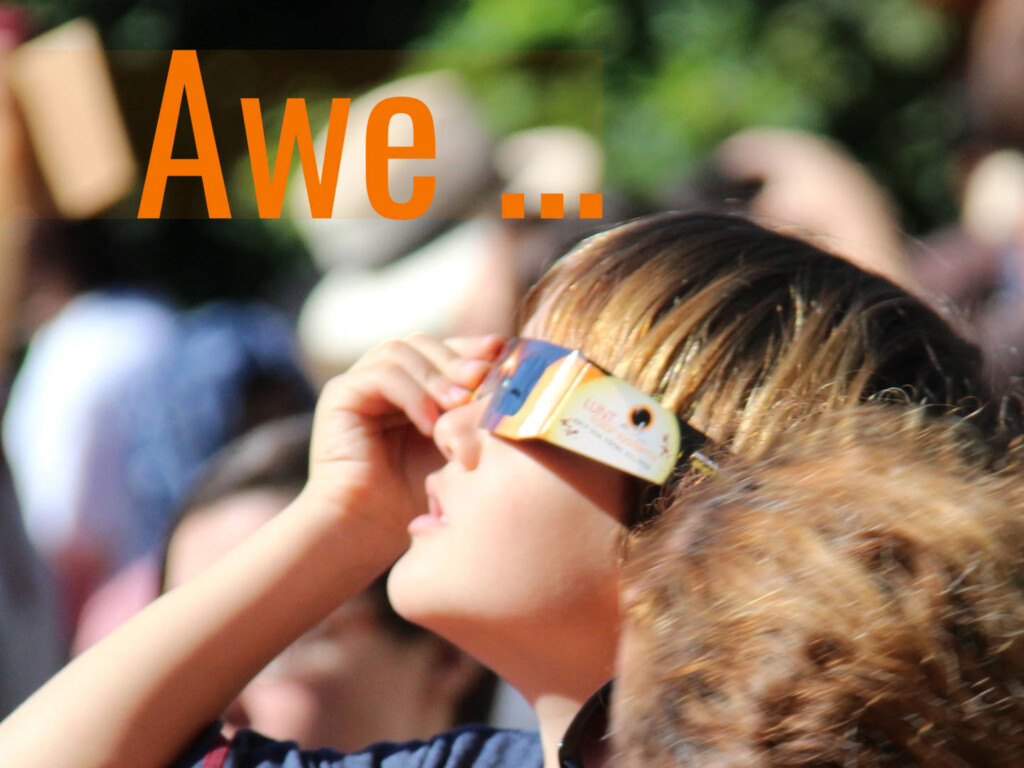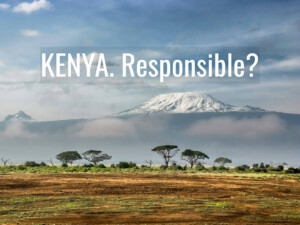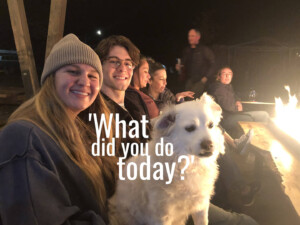Totally awesome: Destinations’ urgent need to rediscover the ‘totality of awe’

A collective sense of smallness, connectedness, and awe elicited by the April 8 solar eclipse reminded K Michael Haywood of the potential that destinations have to inspire awe; from the authentic everyday that host communities may take for granted, to the local effects of larger forces that none of us can afford to ignore.
It’s a “Good Tourism” Insight.
[You too can write a “GT” Insight.]
Contents
Total eclipse
In the lead-up to April 8, 2024, millions of people made the journey to a narrow 120-kilometre wide band of land running across North America, from Mazatlán, Mexico to Newfoundland and Labrador, Canada, to witness and experience one of the rarest of cosmic events: a total solar eclipse.
Eclipse chasers they may not have been, but they marshalled time, money, and a bit of luck to get to optimal locations that would yield clear views.
Fortunately, all I had to do was to walk to our lake to join neighbours as daylight became eerie and morphed into a dusky muted twilight; as the temperature dropped several degrees; and as the birds stopped chirping.
The totality of the solar eclipse elicited unique, visceral feelings as fellow observers gasped with delight. With the moon completely obscuring the disk of the sun, the crowning glory that emerged was the ethereal beauty of the sun’s corona.
They were fleeting moments of breathtaking awe and amazement. Those moments elicited for millions a sense of unity, a reminder of our collective experience of being alive, part of something larger than our mundaneness.
Afterwards, as the moon’s shadow passed, I sensed sadness as people dispersed, only later to be frustrated as so many struggled, homebound, on roadways of immobility.
Awe: Awful or awesome?
As a feeling of transcendence, awe shifts between religious fervour and a humbling respect for the power and beauty of the natural world. Even Albert Einstein, in Living Philosophies, recognised that dance between spirituality and science:
“The most beautiful experience we can have is the mysterious. It is the fundamental emotion that stands at the cradle of true art and true science. Whoever does not know it and can no longer wonder, no longer marvel, is as good as dead, and his eyes are dimmed. It was the experience of mystery — even if mixed with fear — that engendered religion. A knowledge of the existence of something we cannot penetrate, our perceptions of the profoundest reason and the most radiant beauty, which only in their most primitive forms are accessible to our minds: it is this knowledge and this emotion that constitute true religiosity.”
Though still linked with fear of the unknown, awe’s exceedingly positive emotions generate much interest in travel & tourism.
As Dacher Keltner, who wrote the book on awe, revealed, “awe is an emotion [that occurs] when you encounter things you don’t understand […] followed by a sense of wonderment as people seek to explain the mystery (or overcome the threat) of it”.
In these instances, something profound happens. As sentient creatures, we seek to unpack our emotions as we reveal our stories about awe ad infinitum.
Having grown up in the Bahamas, I found awe by looking down (not up); swimming and diving in the majestic azure seas and coral reefs (now in need of restoration) that surround the islands; and by immersing myself in the atmospherics and culture, expressed through calypso music and Junkanoo.
Don’t miss other “Good Tourism” Insights by K Michael Haywood
As travellers, all of us deliberately seek pathways to meaningful experiences (not half-baked, pseudo realities) to explore the totality of those places that are rich and deep in culture, adventure, activities, and sensations; mysterious, mystifying, and awe-inspiring.
Such experiences are always personal and exist forever in our memories.
Mine when my uncle took me to the rolling Yorkshire moors to fly kites. When I witnessed the turbulence of the Atlantic Ocean as 30-foot waves crashed over the bow of our ocean liner on our way to the US.
Since then, experiencing awe in Machu Picchu, Peru, the red stone city of Petra, Jordan, and the glacier near Queenstown, New Zealand.
Every day I am in awe, as I tend my sprawling garden while wild deer munch their way through flowers and shrubs.
From marketing remarkability to exposing awe
Awe shifts attention away from ourselves as we experience things that are greater than ourselves; experiences that change perceptions of time and make us feel more compassionate and appreciative of our world. And not just the wonders of the world, but the wonders that surround and distinguish so many of our communities-as-destinations.
If only, in promoting their remarkability, destinations would be more attentive to discovering and exposing the dormancy of the awe that therein lies; the awe that transcends our knowledge structure. If only destinations’ thinkers, movers, and doers would choose to fully appreciate and apply the new science of awe to magnify the pride, passion, and concern we have for our places and our planet.
We can be doing a far better job at understanding awe’s nuances, accommodating its vastness and totality, not just to impress and drive people’s emotions and senses, but to comprehend the essence of its power.
Whatever places we visit, wherever we take our vacations, the opportunity to enhance the quality of our lives improves when destinations utilise awe to make our lives better; recognise the power of placemaking processes that draw inspiration from mandating happiness (as has been done in Bhutan); processes that can exceed the promise of good times and relational forms of tourism (promoted by all destinations and tourism-related companies), especially when authenticity persists.
Don’t miss other “GT” content tagged ‘Marketing’ &/or ‘Management’
Though mediated through the application of psychographics, the awe in authenticity is not a feeling or outcome that can easily be staged or manipulated, suggesting that cultural representations, historic preservations, or virtual reality excursions to the moon, for example, can be difficult to realise. An exception is Space Explorers – the Infinite because it exemplified, for me, what awe reveals:
- Vastness – beyond the normal range of experience.
- Enlightenment – appreciation for what is being seen, perceived, and achieved.
- Challenge – to what we know or perceive to be true.
- Presence – of beauty, ability, virtue, the sublime and supranatural causality.
- Physiological effects – mind/body sensations; feeling out-of-mind or out-of-body.
- Psychological effects – humility, well-being, life satisfaction, spirituality, connectedness.
- Anxiety and fear.
Adrenaline
Anxiety and fear.
Travel that takes us beyond the everyday can be unnerving and worrisome, especially when places, people, or positions are perceived to be unfamiliar, unsafe, or unsavoury.
Awe heightens our vigilance, caution, and ability to detect threats. It mobilises the mind and body to respond appropriately to perceived danger. I am reminded by how fortunate my best friends were when they outwitted the tsunami that devastated Phuket in 2004.
With extreme hurricanes, massive wildfires, and flooding due to climate change, the dark side of awe is becoming more prevalent. Never has there been a time when the survival of so many communities-as-destinations is coming under threat.
With predictability on the decline, we’re in need of more than catastrophe modellers, particularly as displaced persons are forced to migrate.
Further environmental holocausts loom large.
Unfortunately, the spirit and voices of nature that speak to us through the mystery of awe convey disparate messages: Positivity and negativity; wonder and worry; fun and fear; FOMO (fear of missing out) and FOLLY (fear of losing life and livelihoods, yes).
Action
All of this seems perplexing.
We started out by recognising how awe unites, but now find ourselves asking:
- Are our communities being guided by what matters?
- Are they being challenged to take the right path to totality?
- Are they committed to taking action?
I am yet to be convinced.
What do you think?
Share your own thoughts in a comment below on how travel & tourism stakeholders might leverage awe. (SIGN IN or REGISTER first. After signing in you will need to refresh this page to see the comments section.)
Or write a “GT” Insight or “GT” Insight Bite of your own. The “Good Tourism” Blog welcomes diversity of opinion and perspective about travel & tourism, because travel & tourism is everyone’s business.
“GT” doesn’t judge. “GT” publishes. “GT” is where free thought travels.
If you think the tourism media landscape is better with “GT” in it, then please …
About the author
K Michael Haywood is Professor Emeritus, School of Hospitality, Food and Tourism at the University of Guelph in Ontario, Canada.
“As a former professor and consultant to the hospitality and tourism industries, I now host the Destinations-in-Action blog on substack from my Tourism Studio.”
Michael has also written for The “GT” Travel Blog.
Featured image (top of post)
Millions flock to the best locations to be awed by the total eclipse of the sun. Image by Sima Ghaffarzadeh (CC0) via Pixabay. GT cropped it and added “Awe …”






